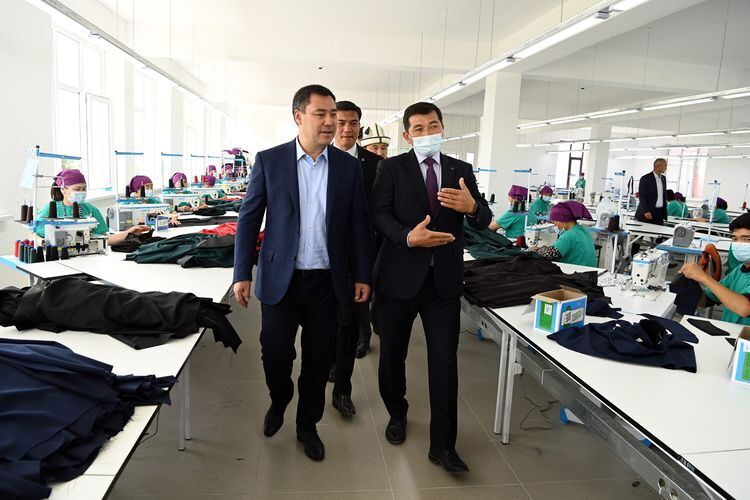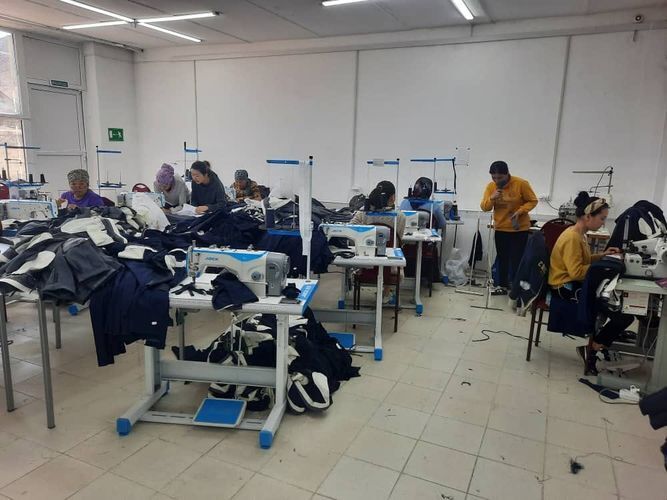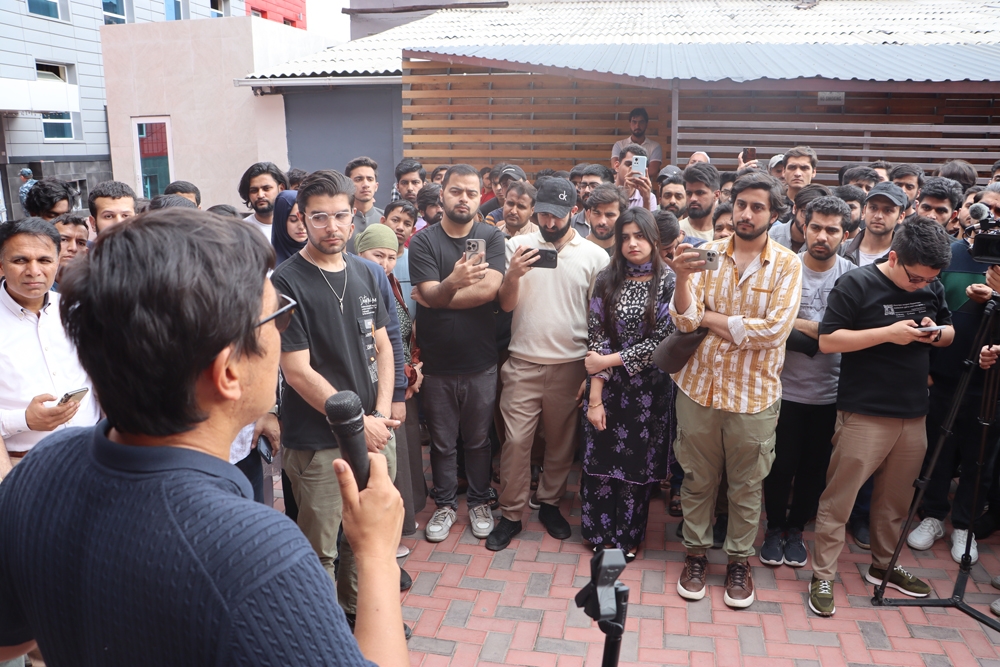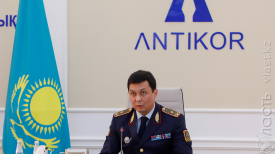Up to 1,000 young men took to the streets of Bishkek in the late hours of May 17 and hit groups of foreign students with unprecedented violence, highlighting growing racial tensions and popular dissatisfaction in Kyrgyzstan.
Читайте этот материал на русском.
According to the chronology provided by the ministry of interior, days earlier, a group of “unknown men of Asian appearance” had harassed foreign students near a restaurant. Chased away, the students rushed back to their dorms, where other students came out in their defense and clashed with the local youth.
A video of this fight circulated across social media in the following days, sparking public outrage, which culminated in mass fighting and looting at the dorms of several universities throughout the city.
On May 22, further news emerged of another attack that was carried out on the night of May 18, when around 70 rioters assaulted a sewing workshop in the village of Alamudun, on the outskirts of Bishkek. As a result, 14 foreign citizens from India, Pakistan, and Bangladesh working in the workshop were injured. Kaktus media reported that 64 sewing workshops in Bishkek had to temporarily shut down because foreign workers left the country after the violent riots.
The official tally of the violent night was of at least 40 injured, 15 of whom were hospitalized. Most of them were foreigners from South Asia and North Africa. So far, charges have been brought against 6 citizens of Kyrgyzstan and 4 foreign citizens.
The May 18 violent outburst revealed the challenges of Kyrgyzstan’s migration policy and the country’s lack of effective policies to respond to new challenges in global migration flows. How did Kyrgyzstan, known for its massive labor migration to Russia and for its labor shortage and lack of career perspectives for young students, become an attractive destination for South Asian students and labor migrants?
Central Asia as an “Education Hub” for South Asian Students
According to official data from Kyrgyzstan’s Statistics Committee, in 2023, 25,774 students from countries outside the Commonwealth of Independent States (CIS, a group of former Soviet countries) are studying at higher educational institutions in Kyrgyzstan. The vast majority are from India (14,424) and Pakistan (9,589), and their presence has increased almost ninefold since 2010.
In comparison, neighboring Kazakhstan has also attracted an increasing number of South Asian students, particularly from India. The ministry of science and higher education reported that there are currently more than 26,000 foreign students enrolled in Kazakhstan’s universities, a 3% increase from the previous academic year. Almost half of them (12,000) are from India and Pakistan, minister Sayasat Nurbek reported.
The majority of students from India and Pakistan in Central Asia study medicine. In 2022, Kyrgyzstan’s ministry of education reported that 77% of medical students were internationals: the majority of them were Indians (14, 456), Pakistanis (9,725), and Uzbeks (5,174). In India, medicine is seen as a prestigious profession, but not everyone can afford to send their children to medical school due to limited availability, high tuition fees, and corruption.
Kyrgyzstan offers medical education in English and relatively affordable tuition fees. Despite doubts about the quality of medical education and cases of students being scammed by private universities, the number of foreigners coming to Kyrgyzstan to obtain medical degrees has grown steadily, leading to the doubling of medical universities in the past few years. Today there are 23 higher education institutions offering a degree in medicine in the country, of which 17 are private.
Medical schools, both private and public, offer education in English at relatively low prices: Tuition fees vary between $1,500-4,000 per year. Private medical schools came under the spotlight in 2022, when the ministry of health found that 17 universities, of which six public and 11 private, did “not-comply with legal requirements.” Another inspection led by the Anti-Corruption Council found the level of professional training in most medical universities to be “a fairly serious problem.”
Pure economic gain and corruption could be behind the heavy marketization of medical education in Kyrgyzstan. International students enrolled in both state and private universities pay tuition fees, which, in the case of state institutions, make up an important share of their budgets.
Fearing a mass exodus of students after the May 18 attacks, state officials published statements underlying the economic benefits of having many foreigners studying in the country.
The rector of the Kyrgyz State Medicine Academy stated in a May 20 interview that international students are “the main investors of the Academy, since tuition fees make up 80% of its budget, while the state only finances 20%.”
Despite the purported “economic value” for the Kyrgyz economy, international students from India and Pakistan have often been the target of verbal and physical assaults, robberies, and extortion.
Illegal Schemes, Harassment, and Violence
Foreign students and workers from Bangladesh, India, and Pakistan were a sizable portion of the people that were detained by the Kyrgyz authorities over the last years on charges of irregular migration status. News stories about the detention of irregular migrants have become more frequent in the first months of 2024.
Since the beginning of 2024, law enforcement agencies have identified 59 cases of organized illegal migration and more than 6,000 violations of migration rules. On May 14, the day after the fight between foreign students and local men, 400 students working as delivery riders were fired because they were on a student visa. The next day, the security service (GKNB) detained 28 Pakistani citizens working in sewing workshops in Bishkek for violating migration laws. The growing media attention towards anti-migrant raids could have contributed to the escalation of events and fueled resentment towards migrants in the country.
On May 18, Kamchybek Tashiev, the head of the GKNB, said in a statement that the growing number of labor migrants had a direct effect on the events of the night before.
“This is due to the influx of migrant workers,” Tashiev said. “Every day [dozens of] illegal migrants are found, and we make every effort to deport them.”
When discussing the mob that attacked foreign students, Tashiev seemed to justify the violence.
”I believe that the demands of the guys who gathered yesterday are, to some extent, correct. We have begun to take measures in response to the increase in the number of migrants,” Tashiev said.
While it is difficult to estimate the scale of irregular migration, Kyrgyzstan operates a quota system for the allocation of work permits to foreign citizens. In recent years, the ministry of labor, social security, and migration has increased the number of work permits from 16,000 to 25,000. While traditionally Chinese specialists were the one receiving the most work permits, now the majority of applicants are citizens of Pakistan, Bangladesh, and India.
The Garment Industry: Hunger for Foreign Labor
The foreign labor quotas are mostly allotted for jobs in the industrial, construction, and transport sectors, due to the increasing demand for cheap labor in the country’s fast-growing garment industry.
In a government program on the development of exports of the Kyrgyz Republic for 2019-2022, the garment industry is listed as the first priority sector. The program estimated that there are around 3,000 enterprises employing between 200 and 300 thousand people, 90% of which women.
In 2023, the ministry of economy reported that clothing production accounts for 90% of the country’s light industry, which includes textile, clothing, leather, leather goods, and footwear production. In 2022, light industry contributed 10% to the GDP, with the textile and clothing industry making up 3% of manufacturing output. Kyrgyz textile and clothing exports made up 22% of total exports in 2022.
Garment manufacturing is export-oriented and labor intensive: most Kyrgyz companies in the industry function as "cut-make-trim" manufacturers, that is they do not design nor produce the textile, which is usually purchased from China or Turkey. In 2020, around 95% of the production was then sold to Russia and Kazakhstan. Notably, the Kyrgyz garment industry is seasonal. During the spring, sewing workshops generally operate at half capacity, which directly affects the number of workers needed and the size of their wages. Plus, given the reliance on imported raw materials, the Kyrgyz garment industry is completely dependent on the fluctuations of the demand for cheap goods on the global market, which in turn has a negative effect on production volumes and working conditions.
Kyrgyzstan’s small and medium-size sewing workshops are mainly owned by individual entrepreneurs working under a patent system. Between 50-70% of the garment industry operates informally. Yet, because this is an export-oriented sector – in 2020, around 95% of the production was then sold to Russia and Kazakhstan – the government has tried to woo foreign investors.
In 2018, Kyrgyz Textile Ltd. launched the construction of a garment factory in Osh, Kyrgyzstan's second largest city. In 2021, the company signed a loan agreement of $4.3 million with the Russian-Kyrgyz Development Fund for financing the expansion of production. Overall, the $153 million investment would spearhead the creation of a textile cluster that could one day provide jobs to 7,000 people.
International donors too have facilitated the opening of apparel factories across the country. In 2020, the USAID Enterprise Competitiveness Project supported the construction of a new apparel factory near the southern city of Batken, becoming one of the biggest employers in a region known for its high unemployment rate and outbound migration.
The government has long considered the garment industry as the solution to the problems of the local labor market, without properly investing in education and training and without addressing labor exploitation and violations of the Labor Code.
Unemployment and Labor Shortage
A large number of people in Kyrgyzstan are involved in the informal economy and this factor is not captured by official statistics. This explains why in the past decade there was a simultaneous decline of the employment rate (64% to 57%) and unemployment rate (8.4% to 5.3%).
According to a recent study, in 2022 only 45% of women were employed, compared to 89% of men, while youth aged 15-29 constituted nearly half of the unemployed. Unemployment thus remains a hidden phenomenon more prevalent among vulnerable groups, which often do not benefit from government employment assistance programs.
Last year, President Sadyr Japarov justified the hiring of 800 workers from Dubai for the construction of a new House of Government with the alleged “laziness” of locals.
“They say there are no jobs. There are. But no one goes to work; if they do, they quickly give up and say it’s difficult”.
In a May 19 interview, Gulnara Baatirova, the minister of labor reported that there are currently more than 6,000 registered vacancies in Kyrgyzstan but that “unfortunately, our citizens often do not want to take hard jobs”.
“Our citizens often do not work regularly. For example, after working in sewing workshops and receiving training, they leave and open their own production. Nobody is against this, but many do not come to work on time, disappear for two or three days after receiving their salary, and ask for time off for celebrations and birthdays,” the minister said. “And business owners need stable production. Several businesses go bankrupt because of those who do not work stably and leave after getting paid.”
The government uses the same rhetoric when addressing labor shortage in the garment industry. During a visit to a new apparel factory in Osh in 2023, then-minister of labor Kudaibergen Bazarbaev said that there is no shortage of jobs, but of workers. According to him, a recruitment plan was needed so that new enterprises could work at full capacity.
Employers also accuse local workers of laziness and unprofessionalism. On the contrary, foreign workers from India, Pakistan and Bangladesh are often praised for their work discipline and hard work.
“Foreigners work from 8:00 to 20:00, they can work overtime, since that is what they come here for. We mainly sew using a conveyor system, and our locals don’t want to work like that. Our people don’t want to go to work on the assembly line”, the founder of an apparel factory explained in an interview with a local media outlet in March.
The narrative about the abundance of jobs and unwillingness of local people to work does not take into account the lack of decent work, low salaries, and multiple barriers to employment, especially for women.
Given that women in Kyrgyzstan shoulder most caregiving responsibilities, including childcare and elder care, many find factory employment incompatible with their family obligations.
Recent research revealed that working conditions in the country’s garment industry are dire and exploitative. Seamstresses work under stress and in unhealthy environments. Most of the surveyed women in a 2019 study said that, when applying for a job, they usually agree on an 11-hour working day, six days a week. The study revealed that almost 30% of respondents in fact worked seven days a week or 10 consecutive days with one day off. Moreover, seamstresses reported to work between two and four hours overtime per day. Most sewing workshops pay on a piecework basis. Despite promising higher-than-average salaries, 43% of workers surveyed in another study said they earned less than 20,000 soms per month ($227) while 47% between 20,000-40,000 soms ($454).
Considering that the majority of sewing workshops are located in the capital Bishkek, where the cost of living is significantly higher than in the rest of the country, these salaries can hardly be called competitive. Higher salaries only reflect longer working hours, not better conditions.
On top of the exploitative working conditions also faced by local workers, migrants from Bangladesh, India and Pakistan are more likely to become victims of scammers and human traffickers. Usually, they find employment in Kyrgyzstan through brokers in their home countries, but they often become victims of scammers, who trick them into paying large sums of money for mediation services, but once in Kyrgyzstan they are left without a work visa and without a job.
Others are given lower salaries than promised and, for fear of being fired and expelled from the country, accept to work in exploitative conditions. They have often complained about not getting the agreed salaries and being forced to work in their employers’ private homes, doing construction work for free.
“I came here six months ago to work at Ibrahim’s workshop in Archa Beshit. They promised a good salary, $600 per month. We agreed that the company would pay for medical insurance and food,” Asadu, a labor migrant from Bangladesh, told Azattyk in an interview in 2022.
“They said that we would work for ten hours a day. We came to work in a sewing workshop, but they forced us to do other work. We were not given the promised food, the $600 salary, or health insurance. Our passports were taken away. When we asked for our passport back, he demanded money. When I decided to return to Bangladesh, he hit me,” Asadu recalled.
Most migrant workers do not speak Kyrgyz or Russian, which makes them even more vulnerable.
A Familiar Dynamic
Xenophobia against South Asian students and labor migrants in Kyrgyzstan echoes the treatment that Kyrgyz and other Central Asian migrants face in Russia on a regular basis. Despite being a member of the Eurasian Economic Union, migrants from Kyrgyzstan face a number of barriers and difficulties when legalizing their status in Russia. This makes them more likely to be subject to exploitation and violations of their labor rights as well as to harassment by ordinary people.
After the terrorist attack at Crocus City Hall, hundreds of Central Asian migrants were fired from their workplaces and deported; others were barred from entering Russia, while in several regions migrant workers have been banned from working in transport and services jobs.
It shows the racialized construction of the “Other” as a threat to the rights of “ordinary” citizens, even when those same citizens are regularly the object of discrimination and labor exploitation abroad.
Blamed for being lazy and preferring to work as labor migrants in Russia rather than contributing to the country’s economic development, local youth pour out their resentment for the lack of decent jobs and welfare against those who are in a more vulnerable position because of their legal status and racialized “otherness”.
Official reactions to the violent attacks have also revealed the opportunistic behavior of the government towards foreign students and workers: South Asian students in medical schools are fueling the demand for private universities and are “investing” in the country’s education system, thus bringing economic gain to the local economy; labor migrants in the garment industry are praised by state officials and local employers for their hard-working culture and discipline, reducing them to a mere commodity.
The institutional humiliation that migrants both Kyrgyz migrants in Russia and South Asia migrants in Kyrgyzstan face is the result of their participation in the commodification and exploitation of labor within global capitalist production systems.
Eugenia Pesci is a doctoral researcher at the University of Helsinki, Finland, focusing on labor in Kyrgyzstan.
Поддержите журналистику, которой доверяют.












